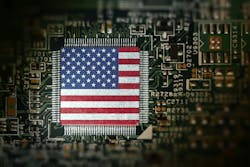Intel Risks Gutting Itself By Spinning Off Its Chip Foundry
In early December, Intel Corp.’s board of directors ousted CEO Pat Gelsinger after a period of poor earnings performance stretching back to 2021. He was replaced with interim Co-CEOs David Zinsner and Michelle Johnston Holthaus, who are charged with maintaining smooth operations while making swift improvements.
Gelsinger rose through the ranks of Intel in the 1980s and ‘90s, becoming CTO in 2001, then leaving to lead virtualization software company VMware in 2009. The Intel board welcomed his return as CEO in 2021 and supported his IDM 2.0 (Integrated Device Manufacturing 2.0) transformation plan to revitalize Intel’s manufacturing capabilities.
But that is not the direction Intel is heading. Facing declining revenues—from $79 billion in 2021 to $54 billion in 2023, with a $16.6 billion loss in the third quarter of 2024—in September, Intel announced its plan to spin off its foundry business into an independent subsidiary.
That is an ill-advised decision. The foundry is the heart of Intel’s manufacturing innovation and IDM 2.0, which is crucial to Intel’s future – not to mention tied to billions in federal funding around chipmaking and national security.
Further reading on semiconductors from other EBM publications:
6 Electronics Sourcing Trends to Watch for in 2025
White House Finalizes $6.6B in Funding to Boost TSMC Chip Production
Undergrad EE Students Await Their Newborn TI-Fabbed Chip Designs
Intel secured nearly $8 billion for the expansion from the U.S. Commerce Department under the CHIPS Act, complementing a previously awarded $3 billion federal contract to help the U.S. military improve its capabilities and secure a domestic supply chain. Construction timelines have been delayed on two semiconductor manufacturing facilities in Licking County, Ohio, while expansion of operations in Chandler, Arizona, is in the early stages and two plants in Rio Rancho, New Mexico, are in the process of being converted into advanced packaging facilities.
Catching Up on Chips
Even with the government incentives for expansion, Intel will have a lot of ground to make up. The company has had no major breakthroughs in chipmaking besides developing and making smaller chips. Now, they are behind in AI chip development and cannot produce 2-nanometer chips — only TSMC and Samsung can.
Spinning off Intel’s foundry operations may offer short-term gains, but it would make the U.S. semiconductor supply chain more vulnerable to disruptions, as the largest, most advanced chip manufacturers are based overseas. It would also put Intel’s federal CHIPs funding at risk. The U.S. government is investing heavily in domestic semiconductor manufacturing to create jobs and ensure a supply of advanced chips designed and produced in the U.S.
If Intel sells off its manufacturing division, it would follow a strategy similar to AMD's transition to a pure chip design company in 2008 by divesting its manufacturing business. AMD's manufacturing division later became GlobalFoundries (GF), now one of the top five foundries globally.
To investors, Intel is a publicly traded company and one of the largest semiconductor chip manufacturers. However, for the U.S. government, Intel’s combined tech and manufacturing innovation—beginning with the company producing the world’s first commercially available microprocessor in 1974—is critical for advanced chip development in the U.S. and the resilience of the defense sector.
Arguments for Keeping Intel a Manufacturer
Keeping Intel as a firm that integrates design, development and manufacturing provides several strategic advantages:
National security: The U.S. government, through the CHIPS Act, has emphasized the need for domestic semiconductor manufacturing to reduce reliance on foreign sources. This is crucial for maintaining secure and reliable supply chains for defense and other critical infrastructure. In addition, Intel has significant contracts with the U.S. Department of Defense to produce advanced semiconductors. Spinning off the foundry operations would jeopardize these contracts and the strategic advantage they provide.
Design for manufacturing (DFM): Keeping design and manufacturing under one roof facilitates seamless integration and communication, process innovation and optimization. This is essential for Intel to design, develop and manufacture advanced AI chips faster, cheaper and better. In-house manufacturing enables Intel to rapidly prototype and iterate new designs, fostering innovation and allowing for customized solutions tailored to specific needs.
Cost, quality and speed: Integrated operations would enable Intel to maintain tighter control over the supply chain to ensure its resilience. Direct oversight of the manufacturing process ensures higher-quality standards and quicker identification and resolution of issues. For example, Samsung's success is often attributed to its vertical integration strategy, which spans from design and manufacturing of semiconductors to consumer electronics. This approach enables Samsung to reduce costs, improve quality, and speed up product development.
Clearly, implementing the IDM 2.0 plan requires advanced technical R&D capabilities, while manufacturing demands ongoing process miniaturization and substantial funding. Tackling both areas simultaneously presents significant technological and operational challenges. It is difficult but not impossible.
Long-term gains often require short-term sacrifice. Can Intel reclaim its leadership as an integrated chip design and manufacturing company, as it was at its inception? Only time will tell.
About the Author

Christopher S. Tang
Distinguished Professor and Ca
Christopher Tang is a distinguished professor and the holder of the Carter Chair in Business Administration at the UCLA Anderson School of Management.
A scholar of global supply chain management, Tang’s interest in his field began in the private sector when he worked for IBM to solve internal production planning problems. Exposure to real-life industry projects motivated his academic research, where he developed teaching cases on microfinancing for the poor, mobile platforms for developing economies and new business models in the age of the Internet, among other topics.
Tang has been a consultant to numerous corporations, including Amazon, HP, IBM, Nestlé and Accenture. He has published six books and in addition to being a regular contributor to IndustryWeek, he has written for the Wall Street Journal, Barron’s, Financial Times, China Daily, Fortune, Bloomberg Law and The Guardian.
